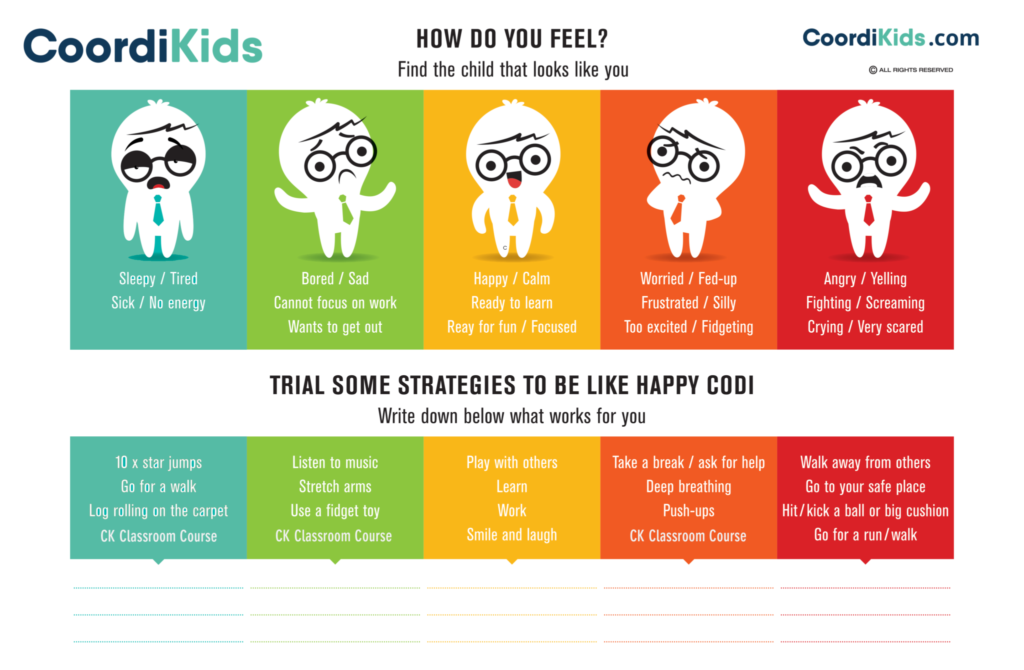Help for School and Kindy
7 Ways Forward-Thinking Schools Include Effective Movement Breaks in the Classroom

7 Ways Forward-Thinking Schools Include Effective Movement Breaks in the Classroom
In response to behaviour trends in elementary and middle school classrooms around the world, some schools have been experimenting with incorporating occupational therapy principles into regular class routines using movement or a brain break in the classroom.
In the U.S., for example, occupational therapy is being viewed as a viable and affordable option for creating inclusive classroom curricula. Rather than separating special needs classes that are often stigmatized (or unfunded), incorporating occupational therapy allows children on a broad spectrum of learning disabilities, motor skills issues, or social challenges to participate in the general curriculum.
All it takes is a bit of flexibility and creativity in your routine. Coupled with an understanding of various challenges faced by a growing number of today’s young students, every classroom can offer better preparation for leading independent lives.
Classroom Trends That Indicate the Need for Occupational Therapy Integration
- Over the past 20 years, most of the public schools that were designated for children with special needs have closed in the US and the UK.
- The Individuals with Disabilities in Education Act of 2003 in the US federally mandates early intervention services in the public education sector for children with special needs for learning. This shifted the approach to special needs by implementing a proactive approach rather than a “waiting to fail” approach.
- The No Child Left Behind Act of 2001 enacted strict standards for education goals state-wide. Each school issues state-wide testing annually in elementary schools to compare education achievements across the board. This upped the pressure on schools to ensure all of their students are thriving. If they don’t, schools are faced with major consequences and students are offered free government-sanctioned assistance.
- The American Occupational Therapy Association has led the way with data-driven research. This is research that guides the incorporation of occupational therapy into mainstream school systems.
Incorporating OT Movement Breaks in the Classroom Doesn’t Have to be Complicated
Rather than singling out individual students who require sensory breaks, movement breaks in the classroom, or a moment for self-regulation, forward-thinking schools are doing things differently.
Forward-thinking schools are incorporating occupational therapy practices and exercises directly into the regular daily school routine for everyone.
Here are a few of our favourite clever and simple strategies for teachers to incorporate therapy into class to benefit all their students at once.
1. Movement Breaks in the Classroom
Even just 5 minutes of physical movement can make a huge impact on any child’s school day. This is true whether they have sensory processing disorder, ADD, ADHD, ASD, dyspraxia or not!
Some schools are getting creative with allowing individual breaks throughout the day. Movement breaks in the classroom are being encouraged. For example, one mom named Skylee says,
“My son’s teacher had little Velcro papers that said, “I Need A Break!” on each child’s desk. They were allowed to hand it to the teacher to earn few mins to get up and move around when they needed it.”
Others are utilizing 5-minute movement breaks for the whole class at once.
A great option:
A great way for teachers to do this is to utilize a program like the Preschool Course (for 4-6 year olds) or Classroom Course (from Year 1 to Year 12).
Each of these programs provides short videos of follow-along physical exercises. Each exercise specifically targets movements that will enhance concentration.
For example, bilateral movements encourage both hemispheres to be active, balance and rhythm supports concentration. Furthermore, an auditory component encourages listening. All in all, in the 5-minute movement breaks in the classroom has three areas of focus.
The focus is on body movements, giving the cortex (thinking brain) a break to refresh, and get ready to concentrate. However, the exercises are fun for all participating children.
The exercises get their muscles moving, oxygen flowing to the brain, and require no additional prep time from the teacher. He or she simply pops on one of the videos, and the class can follow along. (The teacher or any adult can join in to experience the same benefits!)
Here is an example:
One such school that has been implementing the CoordiKids Preschool Course is Bay Terrace. Teacher Bec says,
“I’ve been here for about ten years, and this program has really opened up my eyes as to how intricate children’s bodies, and human bodies are all about as well. The changes that I’ve seen in the children have been through their fine and gross motor skills, but also through their social interactions. It’s really given them a lot of independence and autonomy and in interacting with their peers.
I’ve also noticed that the interactions have been a lot less stressful, in entering and exiting into interplay has been a great observation on my part, and I do credit that to CoordiKids as well, because it’s a very interactive program, and it also pinpoints as to which children need a little bit more help, so that’s really great for us as educators and teachers.”
Proprioception activities
These are types of movement that address any gaps in the awareness of the body in space that might be due to dyspraxia, SPD, ASD or a number of other developmental disabilities.
All children benefit from proprioception activities. These are sometimes called ‘heavy work’ activities. So, many teachers incorporate these movements into daily portions of lesson plans. Moving desks and chairs around for different seating throughout the day is one example (more on this later).
Carrying books, pushing a cart, carrying a stack of lunchboxes, moving mats or gym equipment and stapling and cutting, etc, are all heavy work activities.
Teacher Erica says this. “One thing I do to help with students’ need to move is I have the students do almost everything. They pass out supplies, they sort supplies, they collect supplies. The goal is to always have some movement task for them to do.”
Vestibular stimulation
Vestibular stimulation activities target the vestibular system in the inner ear. This is a system in the inner ear which can be compromised in a wide range of developmental and sensory integration challenges.
The vestibular system is triggered with head movements. Coordination, balance, self-regulation of emotions and focus on tasks can all be strengthened with the practice of vestibular stimulation activities.
A common example is bending over at the waist and straightening back up again. So, anything that moves the head in drastically different directions.
Examples of vestibular stimulation activities for effective movement breaks in the classroom:
Activities that target this system can be easily incorporated through movement learning songs like “Head, Shoulders, Knees and Toes.”
Or:
- create a movement exercise in which students bend over to pick up popsicle sticks or blocks with numbers and letters to spell words or solve math problems
- hang a different number in each corner of the room; then call out a simple number problems; ask the students jump and turn to face the corner with the correct answer
- simply store stationery under the child’s chair; the child has to bend down to pick up pencils, crayons, erasers, etc.
For these reasons, CoordiKids’ Classroom Course includes many vestibular activity options and helps teachers incorporate effective movement breaks in the classroom.
CoordiKids Classroom courses are designed to include exercises specifically shown to help students with attention, focus, posture, and more!
2. Fidget Tools
Speaking of movement, fidget tools and toys have gained tremendous popularity with children. Research has shown that fidgeting with toys improve focus and attention, as well as aid in self-regulation.
In addition to commercially-available fidget tool such as spinners and clickers, there are plenty of DIY fidget tools that teachers can offer within a tight budget. Some teachers are including them in the regular school supplies lists, too!
Others are keeping just a few fidget toys in their own desk. They are then doling them out to students whom they notice getting up frequently, sharpening their pencils over and over, or causing distractions.
The students can have the fidget toy or stress ball for a limited amount of time and then return it to the teacher’s desk.
A possible distraction?
For teachers who are worried that the toys will be a distraction, consider the case study involving a sixth-grade classroom in Georgia. Students who were given stress balls during a writing evaluation had 10% higher scores than when they did not have the stress balls.
Students diagnosed with ADHD had an almost 30% increase in their scores while utilizing stress balls.
Supporters of fidget tools suggest having a strict list of rules surrounding their use to reduce the distraction of the classroom.
3. Alternative Seating
The seating in your classroom makes a big difference on your students’ focus and behaviour.
In addition to assigning or rotating seating locations for students to be able to see better, teachers are experimenting with various seating styles in the classroom.

Most of the preschool classrooms in the US have converted to group tables. This is where multiple students share one large work space, rather than the traditional individual desks.
Many teachers are even allowing students the opportunity to sit on the floor at times. Or they let them stand up and move around during certain portions of the lesson.
Children with dyspraxia or sensory needs can find it challenging to sit still for very long. Fidgeting and wiggling aren’t always just symptoms of hyperactivity or lack of focus. They may also be due to physical challenges with posture.
Breaking up the school day into various types of seating arrangements can benefit students tremendously.
Additionally, trying out alternative seating is a great way for teachers to incorporate occupational therapy principles. They can use these principles to help students develop weak core muscles and improve their balance and posture.
Some alternative seating options include:
- Backless stools
- Elevated desks to allow children to stand when working
- Desks with pedals to encourage physical movement while listening
- An easy DIY option is to wind an elastic exercise band around the legs of the chair, allowing the child to kick against the elastic band
- Exercise/yoga balls
- Cushions
- Bean bags
- Innertubes
- Inflatable seat cushions or pads
4. Chewing Tools
In addition to fidgeting with hands and wiggling in their chairs, some students benefit from chewing tools.
Offering pencil topper chews, chewable bracelets and necklaces, and even sugar-free chewing gum are ways of addressing oral sensory needs to improve focus among students in the classroom.
The jaw muscles are powerful tools to encourage self-regulation and improve concentration. So, you see, movement in the classroom can sometimes just be small movements!
5. Use the “How Do You Feel?” Chart for Self-regulation
Although self-regulation is particularly challenging for students with ADHD, ADD, and ASD, all children must learn how to regulate their emotions.
Having a visual guide of various emotional states is very helpful for children.

Download your copy of the How Do You Feel Chart here.
With practice, they learn to recognize their current state.
With our “How Do You Feel?” chart, children follow along with the character named Codi to see what they can do to feel better.
Each emotional state offers 4 options for the child to try. They can write down which one they like best to use in the future, or they can try a different activity each time.
Having a “How Do You Fee?” chart in your classroom and teaching children how to utilize it will help students with self-regulation over time.
6. Meditation for Self-Regulation
More and more schools are incorporating meditation as part of the regular school day. In 2004 we heard that children with ADHD who meditated with their parents twice each week in therapy sessions had better focus in school.
Another study showed that it took as little as 8 weeks of practicing for an overall trend in improved concentration and fewer hyperactive behaviours in boys with ADHD. So, teachers started getting on board, and the results have been fantastic.
Specifically, a meditation method called the Sahaja Yoga Meditation has been shown to work very well for children. Adding 10 minutes a day of meditation for the whole class is a great way to offer a sensory break to students who need it.
It provides a moment to self-regulate for others, and an overall mind-body “reset” for everyone.
7. Create a Quiet Corner for Sensory Breaks
Students with Sensory Processing Disorder often desperately need a sensory break. Without sensory breaks, they become hyperactive, frustrated, lose the ability to focus on anything, and could even fall prey to a major meltdown.
Yet, even students without SPD can benefit occasionally from having a break from the overstimulation of our current world.
Many teachers have begun creating a corner in their classroom that is void of typical sensory stimulations. So, in addition to movement in the classroom, the opportunity for quiet moments is valuable.
If you’d like to try it yourself, the best quiet spaces include:
- Quiet – use giant cardboard boxes to make a barrier from the sounds of the rest of the classroom, use sound machines for steady white noise, or include a pair of sound-cancelling headphones
- Low light and no visual distractions – hang sheets to block fluorescent overhead lights, use a simple play tent or tunnel, add twinkle lights or a nightlight
- Tactile relief – use soft pillows and plush, velvet or fleece blankets
- Aromatherapy – try scratch-n-sniff books, diffusers, or sprays that children can (safely) use to reset their sense of smell
- Chewing toys – a crunchy snack, sucking juice through a straw, or even chewing tools can offer relief for students who need oral input and pressure